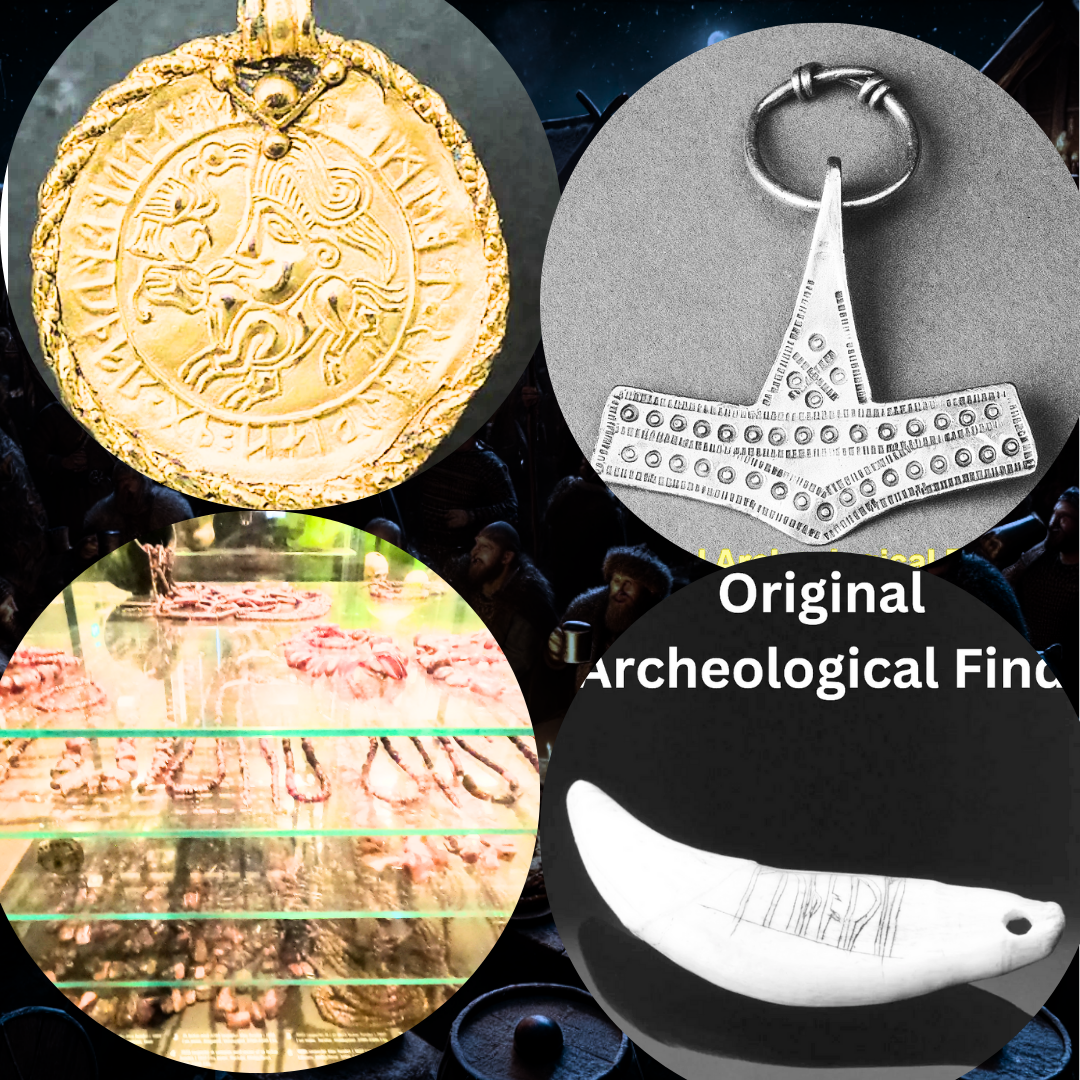
Necklace Viking: Historical Norse Pendants and Their Symbolism
Share
Necklace Viking
Vikings were known for their intricate jewelry with necklaces, pendants and all types of accessories playing a significant role in Norse culture. Whether worn for protection, status, or religious belief, viking necklaces were often crafted from various different materials such as precious metals, bone, amber, and glass beads.
This article explores the most common types of viking necklaces, based on archaeological finds ad historical records. If you’ve ever wondered about what "Necklace Viking" styles were actually worn, read on to discover the true history.
Also check out our entire collection of viking jewelery here.
1. Thor’s Hammer (Mjölnir) Pendants
One of the most iconic viking necklace designs is the Mjölnir pendant, symbolizing Thor’s Hammer. Although these pendants were widely worn across Scandinavia, England, and Eastern Europe, they were not the most common type of necklace worn in the viking age contrarty to popular modern belief.
Less than 100 Thor's hammer pendants have been discovered in the archeology. However, with all the various designs and locations that have been found, there is no doubt that there would have been many more in the viking age and it would have been quite common to see someone wearing one. Another interesting note, they have been found far more often in women's graves than men's. Below are a few of the most known archeological finds.




Why Did Vikings Wear Mjölnir Necklaces?
Although we are not comletely certain for the meaning behind Thor's hammer necklaces, there have been a few theories brought forward by scholars.
- Protection from evil spirits and Christian conversion pressures.
- Symbol of Norse faith in opposition to the Christian cross.
- Talisman for warriors, granting strength in battle.
- A blessing of a new marriage or pregnancy to bring health and fertility
To read about these theories, check out our blog post here.
Related: [The Meaning of Thor’s Hammer Necklace in Viking Culture]
Also, check out our collection of Mjolnir pendants made in Scandinavia and replicas of the archeological finds!

[Thor's Hammer Necklace collection]
2. Viking Bead Necklaces: Amber, Glass & Ceramic
Bead necklaces were especially popular among Viking women, though men also wore them for status and trade wealth representation. Beads were made from imported glass, amber, ceramic and other natural materials, showcasing the Vikings’ vast trade networks.
Types of Viking Beaded Necklaces
-
Amber Necklaces:
- Amber was highly prized and often sourced from the Baltic region.
- Found in Birka and Hedeby, amber beads symbolized wealth and ancient roots
- Popular in the viking age and even Bronze age 3000+ years ago!
-
Glass Bead Necklaces:
- Glass beads came in green, blue, red, and yellow hues.
- The most desirable beads were traded from Byzantium and the Middle East.
-
Ceramic Bead Necklaces:
- A rare but valuable find, ceramic beads were more common in Eastern Viking settlements.
Famous Viking Bead Necklace Accounts & Finds
- Ibn Fadlan’s 10th-century account describes Rus’ Viking women treasuring green glass beads.
- Birka, Sweden, has one of the largest collections of Viking beaded jewelry.
Vast collection of traded beads found in Hedeby(Haitabu Viking Museum, Germany)

Beads found at Kaupang, Norway- Viking Age trade Center

Amber beads dating from Viking age to Bronze Age-National Museum of Denmark

🔗 Related: [Check out our Authentic Amber Beaded Necklace here!]

3. Bracteates: Runic-Inscribed Medallions
Bracteates were thin metal medallions worn as around the neck, often inscribed with runes or mythological imagery. These gold or silver discs were inspired by Roman medallions but were distinctly Norse or Germanic depending on the time period they were from.
Bracteate Characteristics
- Made from gold, silver, or bronze.
- Runic inscriptions often conveyed magical protection or honored Norse gods.
- Many depict Odin, Sleipnir (his horse), or ravens (Huginn and Muninn).
Famous Bracteate Finds



4. Amulets Depicting Norse Gods & Animals
Vikings frequently wore amulets shaped like gods, animals, or sacred symbols.
Types of Viking Amulet Pendants
- Odin Pendants – Representing wisdom, war, and power.
- Raven Pendants – Honoring Odin’s ravens, Huginn (thought) and Muninn (memory).
- Pendants of other gods or figures such as Tyr, Freya, valkyries bears, wolves and more.
Archaeological Finds of Viking Amulets







You can find replicas of many of these here!
🔗 Related: [Norse Pendants collection]
5. Bone & Antler Pendants with Engravings
Beyond metal and stone material, Vikings also used bone and antler pendants, made from various animals, often engraving them with runes or symbols. These pendants were cheaper than metal jewelry but still held deep spiritual meaning.
Characteristics of Bone & Antler Pendants
- Often carved with runes, animal motifs, or protective charms.
- Found in burial sites, suggesting their spiritual significance.
- Sometimes linked to shamanic practices in Viking society.
Archaeological Discoveries of Bone Pendants
- The Ribe Skull Fragment (Denmark) – Features runic inscriptions, indicating ritual use.

- Bear tooth pendant from Orkney Islands

- Antler pendant from Netherlands

We have replicas of these and more at our collection here!
🔗 Related: [Antler & Bone Pendants]
Where to Find Authentic Viking Necklaces Today
For those interested in authentic Viking jewelry, several museums and collections house real Viking necklace artifacts:
🔗 British Museum (London, UK): Home to the Cuerdale Hoard and Norse pendants.
🔗 National Museum of Denmark (Copenhagen): Features bracteates, beads, and silver chains.
🔗 Swedish History Museum (Stockholm): Houses Birka’s Viking necklaces and Mjölnir pendants.
🔗 Hedeby Viking Museum (Germany): Showcases bone and amber jewelry.
If you’re looking to own a Viking-inspired necklace, check out our collection of Norse pendants for historically accurate replicas.
Conclusion: The Legacy of Viking Necklaces
From Thor’s hammer pendants to rune-inscribed bracteates, Viking necklaces reflected power, belief, and craftsmanship. Archaeological finds confirm that Norse necklaces were more than just jewelry—they were symbols of faith, wealth, and protection.
Looking to add a piece of Viking history to your collection? Explore authentic Viking necklaces inspired by real archaeological finds!
